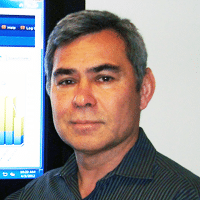For every one kilowatt of energy used in an office building, it takes about two or three kilowatts at a power plant to create that energy, and for Carlos Santamaria, vice president of engineering at Glenborough, that’s a few kilowatts too many.
Something of an energy-conservation crusader, Santamaria is currently working with consultant teams to install metering, wireless pneumatic thermostats (WPTs), and energy controls and to implement mechanical-system upgrades to Glenborough’s 42-year-old corporate headquarters. “What we’re doing at a number of our different buildings and our corporate headquarters is looking at . . . how energy is used in a number of different scenarios—the use and behavior by tenants, miscellaneous building equipment, elevators, things of that nature—to better identify opportunities for energy reduction,” he says.
In light of today’s energy challenges, Santamaria says conservation is an emerging trend across the country. “A lot of your really forward-thinking businesses are doing this—getting in early and making changes so that they’re positioned well for when the market turns and tenants are trying to differentiate buildings,” he says. “A lot of organizations and companies that are very astute ask prior to leasing space about the sustainability program. They want to be a part of a building that’s forward-thinking. As our economy starts to improve and you see businesses become more aware of their overall expenses, commercial office space is usually number one or number two in controllable expenses in budgets.”
Glenborough was established more than 30 years ago as a privately held, full-service real estate investment, management, and development company focused on the acquisition, management, and leasing of high-quality commercial properties. It focuses on both new developments as well as major renovation work on existing properties. Sustainability is a huge focus in new development in addition to energy management while overseeing portfolios of more than five million square feet. The company works closely with its energy consultants to reduce energy use and the carbon footprints of the developments it owns and its own corporate offices.
Glenborough’s headquarters at 400 S. El Camino Real in San Mateo boasts 144,000 square feet of office space. Evenings and weekends can be the biggest culprits when it comes to energy waste, Santamaria says, and Glenborough is combating this by converting from traditional thermostats, which Santamaria says are “extremely inefficient and waste a lot of energy,” to direct digital control (DDC) devices. Manufactured by Cypress Envirosystems, the systems provide increased control functionality at a fraction of the cost, and installation can take as little as 20 minutes, which can also be less intrusive to tenants than traditional wired systems.
“What makes these Cypress wireless pneumatic thermostats the latest technology [to change] our industry is the different capabilities of the technology,” Santamaria says. “These WPTs provide owners the ability to view each and every zone in a pneumatic system while increasing control and tenant comfort while also having the capability to reduce energy significantly.”
“One kilowatt turned off is a kilowatt saved. That’s the most simplistic way of looking at energy in an office building.”
-Carlos Santamaria, Glenborough
In conjunction with KW Energy and PG&E, Glenborough has been selected to undergo a technology assessment. The project is being completed through the PG&E On Bill Financing program. With energy incentives totaling $41,000 and annual energy savings and reduced maintenance costs totaling more than $42,000, Santamaria said the assessment is expected to pay for itself in less than three years. “What makes this project such an important upgrade is the ability to control these remotely and through the Web,” Santamaria said. “Our tenant comfort and retention will be enhanced thus making this an extremely successful choice for an upgrade.”
Glenborough also is taking a comprehensive approach by looking at a spectrum of energy arenas. “Through the use of our EFT Energy Manager … system,” Santamaria explains, “we’re looking at every particular energy-use load and taking time to say, ‘Is there something out there that can run more efficiently or use less wattage? Do you really need all those printers and copiers? Do you need to run fans on weekends?’”
As companies look for innovative ways to reduce their carbon footprints, Santamaria says the focus has shifted in the real estate industry to specialize in energy management and tenant education. “Property and facility managers have to wear a higher number of different hats,” he says, “knowing that in order to fully understand a number of our trades and real estate disciplines, a higher level of specialization and or education must occur. From my background, I was very lucky to have been in the trenches learning building operations and development early on while also pursuing the property management side of the business.”
Santamaria says there needs to be a major effort by those who have long been in the business to pass on that information to those just starting out. He lauds the Building Owners and Managers Association for doing just that. During BOMA’s annual convention in Seattle, Santamaria moderated a presentation called “Energy Leadership: Defining Our Role,” which was led by various leaders of today’s commercial real estate industry.
A father of two boys, Santamaria takes his work home with him when it comes to energy conservation by impressing upon his sons the value of environmentalism through language only a vice president of engineering might use. “I tell them, one kilowatt turned off is a kilowatt saved,” he says. “That’s the most simplistic way of looking at energy in an office building.”



